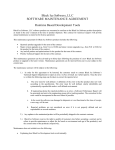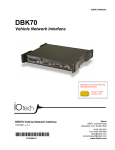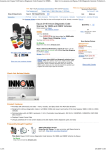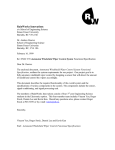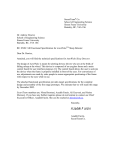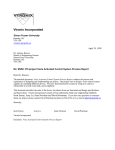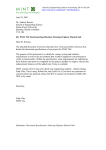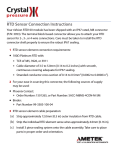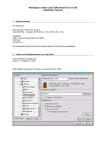Download Functional Specification for an Automotive Diagnostic System
Transcript
School of Engineering Science Burnaby, BC V5A 1S6 [email protected] October 6, 2003 Dr. Andrew Rawicz School of Engineering Science Simon Fraser University Burnaby, British Columbia V5A 1S6 Re: ENSC 340 Functional Specification for an Automotive Diagnostic Tool Dear Dr. Rawicz: The attached document, Functional Specification for an Automotive Diagnostic System, outlines our design project for ENSC 340 (Engineering Project). We are in the process of designing a system that will interface with existing diagnostic ports on late-model automobiles, thereby providing hobby mechanics and sport enthusiasts with inexpensive access to detailed information from the car’s computer. This functional specification details all of the high-level requirements for the operation of our device. Included in this document is a complete specification for a proof-of-concept prototype, to be delivered by mid-December, 2003, as well as a partial set of requirements for future production-quality versions. NVision Technologies is a group of four talented, enthusiastic and creative third-year engineering students: Jozsef Dudas, Seema Jaffer, Deanna Lee, and Byron Thom. Should you have any questions or concerns, please feel free to contact me via telephone at 604-773-9712 or email at [email protected]. Sincerely, Jozsef Dudas President and CEO NVision Technologies Enclosure: Functional Specification for an Automotive Diagnostic System Functional Specification for an Automotive Diagnostic Tool NVision Technologies: Jozsef Dudas Seema Jaffer Deanna Lee Byron Thom Contact Person: Jozsef Dudas [email protected] Submitted to: Dr. Andrew Rawicz – ENSC 340 Steve Whitmore – ENSC 305 School of Engineering Science Simon Fraser University Issue Date: October 6, 2003 Revision: 0 [email protected] Functional Specification for an Automobile Diagnostic Tool September 15, 2003 Executive Summary The constantly increasing complexity of recent automobiles requires hobby mechanics and sports car enthusiasts to purchase expensive electronic tools to appropriately enjoy their hobby. With the automotive diagnostic tool, users can communicate directly with the computer in their car, allowing them to retrieve real-time sensor data and malfunction codes, as well as modify operating parameters in the computer at an affordable price. Enthusiasts can then diagnose problems and improve performance at the click of an economical button! Development of the product will occur in multiple stages. The first stage, to be completed by mid-December, 2003, will be a proof-of-concept device including the following features: • • • • Full communications link with the car’s onboard computer in late-model GM vehicles, via the SAE J1850 VPW protocol. User interface that provides colourful and easy viewing of sensor data. Support for accessing a handful of the most common vehicle sensors. Ability to read malfunction codes from the automobile computer. In addition, a fully consumer-ready, production device will be created, which will satisfy the following requirements: • • • • Implement communication links to all major automobile vendors. Software will be upgradeable to support future automobile standards. Extendible support for all available sensors across all makes and models of automobiles. Functionality to tweak, upgrade, and reprogram software on the vehicle’s computer. A target completion date has not been set for this final stage of development. Copyright © 2003 NVision Technologies. Proudly sponsored by ii [email protected] Functional Specification for an Automobile Diagnostic Tool September 15, 2003 Table of Contents Executive Summary ............................................................................................................ ii Table of Contents............................................................................................................... iii Glossary .............................................................................................................................. 1 1 Introduction................................................................................................................. 2 1.1 Scope................................................................................................................... 2 1.2 Intended Audience .............................................................................................. 2 1.3 Objectives ........................................................................................................... 2 2 System Requirements.................................................................................................. 4 2.1 System Overview ................................................................................................ 4 2.2 Physical Requirements........................................................................................ 4 2.3 Power requirements ............................................................................................ 5 2.4 Environmental Specifications ............................................................................. 5 3 Translator Cable.......................................................................................................... 6 3.1 Communications with PCM................................................................................ 6 3.2 Communications with User Interface ................................................................. 6 4 User Interface Requirements....................................................................................... 7 4.1 Compatibility ...................................................................................................... 7 4.2 Communications to Translator Cable ................................................................. 7 4.3 Graphical User Interface ..................................................................................... 7 4.3.1 Specific Function Requirements ................................................................. 8 5 National Standards and Regulatory Compliance ........................................................ 9 Copyright © 2003 NVision Technologies. Proudly sponsored by iii [email protected] Functional Specification for an Automobile Diagnostic Tool September 15, 2003 Glossary CSA Canadian Standards Association ISO 9141 International Standards Organization OBD-II communication mode, used by Chrysler and most foreign cars. One of three hardware layers defined by OBD-II J1850 An SAE Standard set on March, 1998 on Verification Test Procedures. One of three hardware layers defined by OBD II. J1962 An SAE Standard set on June, 1992 on Diagnostic Connector J2190 An SAE Standard set on June, 1993 on Enhancing E/E Diagnostic Test Modes OBD-II On Board Diagnostics 2. A standard for interfacing with all automobiles manufactured after 1996. PCM Powertrain Control Module. The most sophisticated form of the automobile computer that electronically controls all drive functions from fuel management to gear selection for an automatic transmission. PWM Pulse Width Modulated RS-232C Recommended Standard-232C, a standard interface approved by the Electronic Industries Alliance (EIA) for connecting serial devices. SAE Society of Automotive Engineers UI User Interface USB Universal Serial Bus VPW Variable Pulse Width Copyright © 2003 NVision Technologies. Proudly sponsored by 1 [email protected] Functional Specification for an Automobile Diagnostic Tool September 15, 2003 1 Introduction The automotive diagnostic tool will interface directly with the electronics on newer vehicles in order to deliver a wide range of information about the internal operation of the automobile to the user. This link is made possible by connecting to the automobile’s central computer via the OBD-II standard interface. This protocol gives the hobby mechanic access to real-time data from sensors distributed throughout the vehicle, information about potential malfunctions detected by the computer, and the ability to reconfigure the internal computer. Our project will be completed in a series of stages, with each one building closer to a production-quality unit. The first stage, a proof-of-concept device produced for ENSC 340, is slated for completion by mid-December, 2003. 1.1 Scope This document describes the functional requirements for a fully functional automotive diagnostic tool. The proof-of-concept stage is fully defined herein, and the requirements for the subsequent states are provided as an ideal wish list. Substantial development work will have to be completed to bring this product to market, so it is expected that final requirements will evolve with experience gained from earlier prototypes. This document fully illustrates all aspects of our product, and becomes a model for all our design decisions. 1.2 Intended Audience Design engineers will use this document to create design specifications for components of the automotive diagnostic tool. Financial and marketing representatives (entrepreneurial engineers) will use this document to secure venture capital and other sources of funding for prototype development. Quality engineers will use this document to verify the final product has met intended specifications. 1.3 Objectives This document will use the following convention to denote requirements: [R#] A functional requirement The following convention will be used to show distinction between requirements for each stage of development: Copyright © 2003 NVision Technologies. Proudly sponsored by 2 [email protected] Functional Specification for an Automobile Diagnostic Tool September 15, 2003 (1) (2) (3) Applicable only to the proof-of-concept device. Applicable to proof-of-concept device and all subsequent iterations Applicable to only production units. In addition, this document makes use of the terms shall, and should. The term shall indicates a requirement that must be met for the product to be successful. However, requirements specified with should are enhancements that will increase the appeal of the product, but can be omitted when considered with certain constraints. Copyright © 2003 NVision Technologies. Proudly sponsored by 3 [email protected] Functional Specification for an Automobile Diagnostic Tool September 15, 2003 2 System Requirements 2.1 System Overview The diagram in Figure 1 shows a qualitative system overview of the product. The PCM collects data from various sensors throughout the car and performs various diagnostic and control functions. The user can request data via the graphical user interface, which then is relayed to the PCM via the translator cable and returned along the same route. All interaction occurs at the user interface, while the translator cable connects to a port on the car, located within 2 feet of the steering wheel. Temperature sensor Automobile Automobile PCM Internal Computer Translator Cable User Interface Speed sensor Figure 1 – System Overview 2.2 Physical Requirements R[1] R[2] R[3] R[4] R[5] The User Interface shall be small enough to be considered “hand-held.” (3) The Translator Cable shall be long enough to allow using the device anywhere in the car. (2) The Translator Cable shall be small enough to afford operation during driving conditions. (2) The User Interface shall afford some means of attachment to the automobile’s dash. (3) The Translator Cable shall connect to the vehicle via a standard OBD-II jack (i.e. conformance with SAE J1962). (3) Copyright © 2003 NVision Technologies. Proudly sponsored by 4 [email protected] Functional Specification for an Automobile Diagnostic Tool September 15, 2003 2.3 Power requirements R[6] R[7] R[8] R[9] The entire product shall be powered entirely via the OBD-II connection. (3) The User Interface should include battery power to afford operation after disconnecting from the vehicle (i.e. to retrieve data, etc.). (3) The User Interface and Translator Cable may be powered from external power as needed. (1) The entire product shall draw minimal power so as to afford 4 hours of operation while the vehicle is off, without affecting its ability to start (i.e. 12V current draw should not exceed 300 mA). (3) 2.4 Environmental Specifications R[10] The entire product shall operate as intended throughout the extended automotive temperature range (-40 ˚C to 120 ˚C). (3) R[11] The product shall not be waterproof. (2) R[12] The User Interface shall withstand the shock of being dropped onto concrete from a height of 1m. (3) R[13] The Translator Cable shall withstand the shock of being dropped onto concrete from a height of 1m. (3) R[14] The product shall not be serviceable by the end user. (3) R[15] Barring excessive abuse, the product shall provide a service life in excess of 5 years. (3) Copyright © 2003 NVision Technologies. Proudly sponsored by 5 [email protected] Functional Specification for an Automobile Diagnostic Tool September 15, 2003 3 Translator Cable R[16] The Translator Cable shall repackage incoming J2190 standard to outgoing J1850 standard. (2) R[17] The Translator Cable shall be an autonomous, stand-alone unit. (2) R[18] The Translator Cable shall have the ability to be removed and inserted into the OBD-II port at any time. (3) R[19] The Translator Cable should not crash – ever. (2) 3.1 Communications with PCM R[20] The Translator Cable shall implement the J1850 VPW standard. (2) R[21] The Translator Cable shall implement the J1850 PWM and ISO 9141 standard. (3) R[22] The Translator Cable should have the ability to communicate via all low-level physical layer standards. (3) (same as above) R[23] The Translator Cable should be software upgradeable for future standards. (3) 3.2 Communications with User Interface R[24] The Translator Cable shall transmit data from J1850 standard to the iPaq, without errors. (2) R[25] The Translator Cable shall communicate via RS-232C to the UI. (2) R[26] The Translator Cable should communicate via USB to the host/UI. (3) R[27] The Translator Cable shall provide buffering of some sort for the PCM data. (2) Copyright © 2003 NVision Technologies. Proudly sponsored by 6 [email protected] Functional Specification for an Automobile Diagnostic Tool September 15, 2003 4 User Interface Requirements These are the User Interface Requirements that are necessary to ensure compliance with the System Requirements. They will also affirm the efficient and reliable use of the system. 4.1 Compatibility R[28] The User Interface shall run on a WinCE handheld device. (2) R[29] The User Interface shall run on desktop Windows and WinCE devices. (1) 4.2 Communications to Translator Cable R[30] The User Interface shall package local user commands in the J2190 protocol to transmit to the Translator Cable. (2) R[31] The User Interface shall automatically detect a connection to the translator cable on start-up. (2) R[32] The User Interface shall monitor the connection to the Translator Cable and report any errors and/or disconnections to the user. (2) R[33] The User Interface shall communicate via a serial connection to the Translator Cable utilizing the RS-232C serial protocol. (1) R[34] The User Interface should communicate via a serial connection to the Translator Cable utilizing the USB 1.1 serial protocol. (3) 4.3 Graphical User Interface These requirements define how the user will interact with the automotive diagnostic tool. Refer to the System Overview for a more detailed description. R[35] The User Interface shall be able to display information pertaining to the car’s status. (2) R[36] The User Interface shall have a full colour display with various graphics capabilities. (2) R[37] The User Interface should have user configurable skins. These will allow users to personalize their display to match their car and personal needs. (3) R[38] The User Interface should be designed to incorporate small-screen design techniques. (2) Copyright © 2003 NVision Technologies. Proudly sponsored by 7 [email protected] Functional Specification for an Automobile Diagnostic Tool September 15, 2003 R[39] The User Interface shall utilize the PDA’s touch-screen capabilities as user inputs. (2) R[40] The User Interface shall utilize the PDA’s buttons as user inputs. (2) 4.3.1 Specific Function Requirements R[41] The User Interface shall be able to quickly display requested information in a graphical format. (2) R[42] The User Interface shall specifically utilize dials when displaying appropriate streaming information. (2) R[43] The User Interface shall have the ability to save and display the raw data coming from the Translator Cable. (2) R[44] The User Interface shall run efficiently enough to calculate and display the horsepower to speed curve. (1) R[45] The User Interface shall incorporate the set of sensors necessary to calculate the horsepower to speed ratio. (1) R[46] The User Interface’s sensor data definitions should be configurable via a userspecified configuration file. (3) R[47] The User Interface should have built-in security features to ensure that the user does no inadvertently mess with sensitive data. (3) R[48] The User Interface will have three modes of operation: a. The User Interface shall have a sensor display mode. (2) b. The User Interface shall have a trouble-shooting mode. (2) c. The User Interface should have a PCM reprogramming mode (3) R[49] The User Interface shall have a back-up option whereby it stores the entire content of the PCM in case of a reprogramming error. (3) Copyright © 2003 NVision Technologies. Proudly sponsored by 8 [email protected] Functional Specification for an Automobile Diagnostic Tool September 15, 2003 5 National Standards and Regulatory Compliance The automotive diagnostic tool must connect to electronics in a wide range of automobiles. The relevant SAE standards are listed in previous sections. However, as a consumer electronics device, this product must comply with a number of general safety and operability standards. R[50] The device shall comply with all CSA and UL requirements pertaining to users handling electronics equipment. (3) R[51] The device shall comply with all CSA requirements pertaining to the connection of electronics to automobiles. (3) R[52] The device shall comply with all CSA and FCC requirements on electromagnetic radiation from consumer electronics. (3) Copyright © 2003 NVision Technologies. Proudly sponsored by 9 [email protected] Functional Specification for an Automobile Diagnostic Tool September 15, 2003 6 User Documentation Although automobile enthusiasts are typically very knowledgeable about their automobiles, they may be as experienced with the required electronics. As such, adequate documentation and resources must be provided to assist our customers at succeeding in their intended goals. R[53] The product shall include a printed user’s manual in all languages applicable to the country of sale. (3) R[54] A truncated copy of the user’s manual shall be available an online help feature within the User Interface. (3) R[55] The user’s manual shall detail the modes of operation of the User Interface, demonstrate how to upgrade the device, and outline how to enhance the sensor data configuration. (3) R[56] The user’s manual shall not explain matters relating to auto repair. (3) R[57] The user’s manual shall not provide a comprehensive listing of available sensors. Users will be referred to the appropriate standards documentation (which may be made available on an accompanying CD). (3) R[58] No formal documentation outside of the Design Specification will be provided for prototype units (1). R[59] The intended audience for all documentation shall be hobby-level mechanics with limited experience with electronics and computers. (3) Copyright © 2003 NVision Technologies. Proudly sponsored by 10 [email protected] Functional Specification for an Automobile Diagnostic Tool September 15, 2003 7 Conclusion The requirements specified herein describe the automotive diagnostic tool in its entirety. Requirements labelled as (1) or (2) will be incorporated in our team’s proof-of-concept design, slated for completed by mid-December, 2003. In addition, we have considered the features that will make this a marketable and successful product, and have included specifications for a final product, labelled as (3). Copyright © 2003 NVision Technologies. Proudly sponsored by 11















